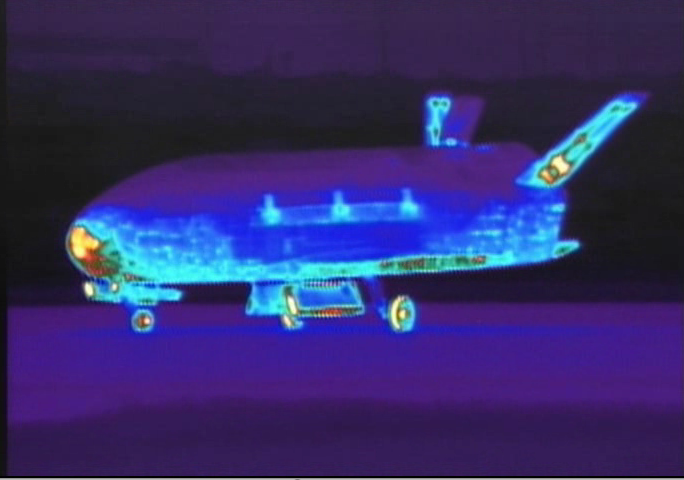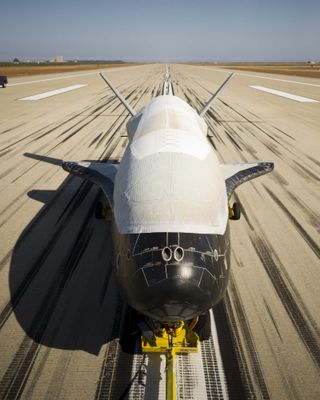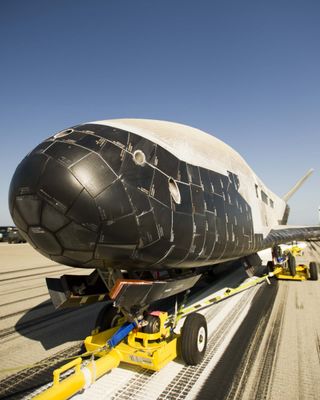
The U.S. Air Force's robotic X-37B space plane came back to Earth today (June 16) after 15 months in orbit on a mystery mission, and its much-anticipated landing was caught on video.
The X-37B spacecraft touched down at California's Vandenberg Air Force Base at 5:48 a.m. local time Saturday (8:48 a.m. EDT; 1248 GMT). Several hours later, Vandenberg officials released a short video of the event.

The first part of the 80-second video was apparently shot in infrared light. It shows the X-37B space plane cruising in for an automated landing, its belly and nose glowing a bright orange-yellow, presumably from the heat generated during re-entry to Earth's atmosphere.
The video switches over to visible wavelengths about 35 seconds in, after the space plane has touched down, and shuts off shortly after the X-37B rolls to a stop on the runway. [Photos: Air Force's 2nd Secret X-37B Mission]
The X-37B, also known as Orbital Test Vehicle-2 (OTV-2), launched on March 5, 2011, from Florida's Cape Canaveral Air Force Station. Its flight was the second-ever mission for the X-37B program; the first was flown by OTV-2's sister ship, OTV-1.
OTV-1 blasted off in April 2010 and stayed aloft for 225 days, well below the supposed 270-day orbital limit for the space plane. But OTV-2 smashed that limit, zipping around our planet for 469 days before finally coming down today.
Just what OTV-2 was doing up there for so long remains a mystery. Details of the vehicle's mission are classified, as are its payloads. The secrecy has spurred speculation — notably from China — that the X-37B may be a space weapon of some sort, but Air Force officials have long insisted that the spacecraft is simply testing out technologies for future satellites.
Get the Space.com Newsletter
Breaking space news, the latest updates on rocket launches, skywatching events and more!
The X-37B looks like NASA's recently retired space shuttle, but it's far smaller. The X-37B is 29 feet (8.8 meters) long and 15 feet (4.5 m) wide, with a payload bay about the size of a pickup truck bed. For comparison, two X-37B vehicles could fit inside the payload bay of a space shuttle.

The 11,000-pound (5,000-kilogram) space plane's orbital longevity is enabled by its solar array, which generates power after deploying from the payload bay.
The X-37B is built by Boeing, though NASA originally used the vehicle as an experimental test bed until funding for the project ran out in 2004. The space plane then passed to the Defense Advanced Research Projects Agency, and it was ultimately turned over to the Air Force in 2006.
Follow SPACE.com senior writer Mike Wall on Twitter @michaeldwall or SPACE.com @Spacedotcom. We're also on Facebook and Google+.
Join our Space Forums to keep talking space on the latest missions, night sky and more! And if you have a news tip, correction or comment, let us know at: community@space.com.

Michael Wall is a Senior Space Writer with Space.com and joined the team in 2010. He primarily covers exoplanets, spaceflight and military space, but has been known to dabble in the space art beat. His book about the search for alien life, "Out There," was published on Nov. 13, 2018. Before becoming a science writer, Michael worked as a herpetologist and wildlife biologist. He has a Ph.D. in evolutionary biology from the University of Sydney, Australia, a bachelor's degree from the University of Arizona, and a graduate certificate in science writing from the University of California, Santa Cruz. To find out what his latest project is, you can follow Michael on Twitter.